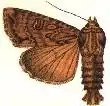Apamea apamiformis
Apamea apamiformis, known by the common names rice worm moth, riceworm,[1] and wild rice worm,[2] is a moth of the family Noctuidae. It is found in North America, including Wisconsin,[3]: 23 New York, Minnesota and eastern Canada, with imperiled or critically imperiled populations in Maryland and Indiana, respectively, and a vulnerable population in New Jersey.[4]
| Apamea apamiformis | |
|---|---|
 | |
| Scientific classification | |
| Domain: | Eukaryota |
| Kingdom: | Animalia |
| Phylum: | Arthropoda |
| Class: | Insecta |
| Order: | Lepidoptera |
| Superfamily: | Noctuoidea |
| Family: | Noctuidae |
| Genus: | Apamea |
| Species: | A. apamiformis |
| Binomial name | |
| Apamea apamiformis Guenée, 1852 | |
| Synonyms | |
| |
Description
The adult's wingspan is about 39 millimetres (1.5 in). Adults are dimorphic, with a dark form and a light form distinguished by the coloration of the forewing.[5]: 37–38 The reniform spot is dark[5]: 25 with white scales along that spot's concave border (facing the forewing's outer margin).[5]: 38
Life cycle and behavior
Adults are on wing from June to August depending on the location. They feed on nectar from common milkweed flowers.[6]
Eggs are laid in the florets of wild rice from late June or early July until early August.[6] The eggs hatch after eight or nine days and the larvae eat the ovary of their floret before ballooning away on self-spun silk threads.[6] By the third instar they begin to consume maturing grain in the flower heads of the wild rice.[6] Starting in September the larvae, now in the sixth or seventh instar, will either bury themselves in soil[6] or will have already bored themselves into the rice stalks,[5] where they overwinter before emerging in mid-spring to feed, moult into the eighth instar and subsequently pupate.[5][6]
Economic importance
The larva is known as the most serious insect pest of cultivated wild rice in Minnesota,[2] and perhaps the entire Upper Midwest of the United States.[7] The larvae may be mistaken for rice grains during harvesting.
References
- Apamea apamiformis. Invasive Species List and Scorecards for California. California Invasive Species Advisory Committee. 2010.
- Nelson, J. J. Insect Pests: Wild Rice Worm. Archived January 27, 2012, at the Wayback Machine Crop Profile for Wild Rice in Minnesota. NSF Center for Integrated Pest Management & USDA. 2000.
- Ferge, Leslie A.; Balogh, George J.; Johnson, Kyle E. (June 2018). "Checklist of Wisconsin Moths" (PDF). Wisconsin Entomological Society Special Publication No. 6. Retrieved 30 July 2022.
- Schweitzer, Dale F. (30 September 2022). "Apamea apamiformis". NatureServe Network Biodiversity Location Data accessed through NatureServe Explorer. Arlington, Virginia: NatureServe. Retrieved 27 October 2022.
- Mikkola, Kauri; Lafontaine, J. Donald; Gill, Jocelyn D. (2009). "Fascicle 26.9, Noctuidea, Noctuidae (part): Xyleninae (part): Apameini (part—Apamea group of genera" (PDF). In Hodges, Ronald W.; Brown, Richard L.; Davis, Donald R.; Lafontaine, J. Donald; Powell, Jerry A.; Solis, M. Alma (eds.). The Moths of North America. Washington: The Wedge Entomological Research Foundation. ISBN 978-0-933003-14-9. Retrieved 30 July 2022.
- Peterson, A.G.; Noetzel, D.M.; Sargent, J.E.; Hanson, P.E.; Johnson, C.B.; Soemawinata, A.T. (1981). "Insects of Wild Rice in Minnesota". St. Paul, Minnesota: University of Minnesota. R157. Retrieved 30 July 2022.
- Oelke, E. A. 1993. Wild rice: Domestication of a native North American genus. p. 235-43. In: Janick, J. and J. E. Simon (eds.), New Crops. Wiley, New York. Accessed 30 July 2022.
External links
Further reading
- MacKay, M. R. and E. W. Rockburne. (1958). Notes on life-history and larval description of Apamea apamiformis (Guenée), a pest of wild rice (Lepidoptera: Noctuidae). The Canadian Entomologist 90(10), 579-82. doi:10.4039/Ent90579-10